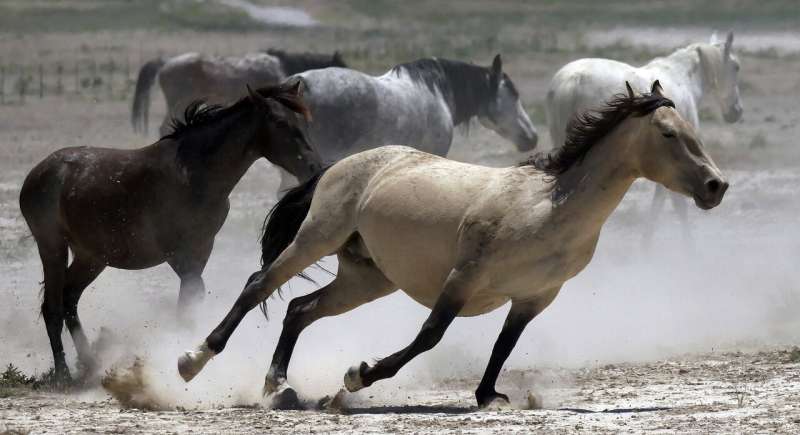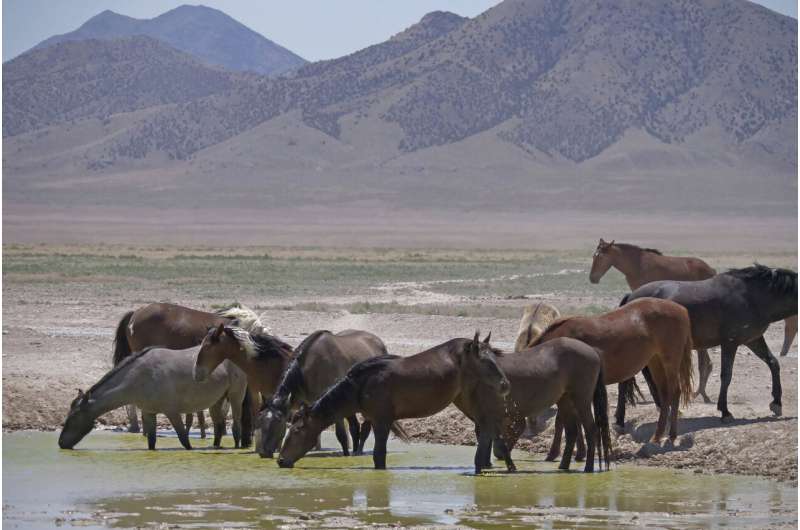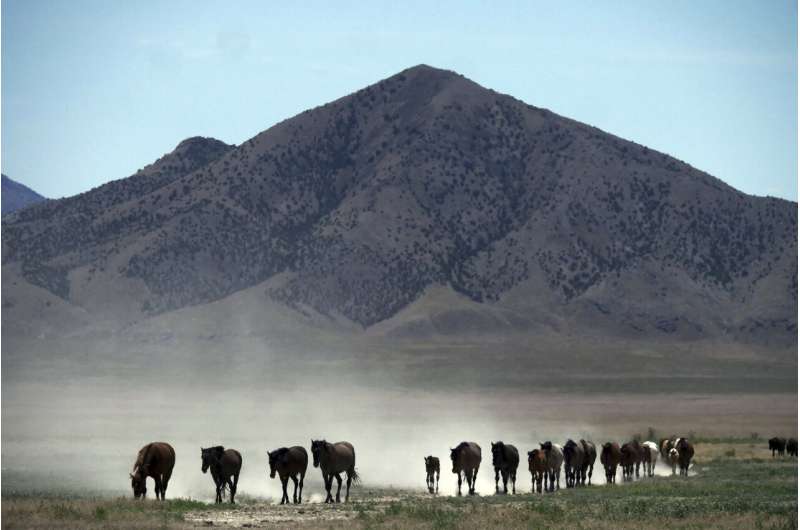In this June 29, 2018, file photo, wild horses kick up dust as they run at a watering hole outside Salt Lake City. Acting U.S. Bureau of Land Management Director William Perry Pendley says it will take $5 billion and 15 years to get an overpopulation of wild horses under control on western federal lands. But he told reporters Wednesday, Oct, 23, 2019, several new developments have made him more optimistic than he's been in years about his agency's ability to eventually shrink the size of the herds from 88,000 to the 27,000 he says the range can sustain ecologically. (AP Photo/Rick Bowmer, File)
It will take $5 billion and 15 years to get an overpopulation of wild horses under control on federal lands across the West, the acting head of the U.S. Bureau of Land Management said Wednesday, adding that several developments have made him more optimistic about his agency's ability to get the job done.
William Perry Pendley announced the agency adopted out more than 7,000 mustangs and burros captured last year—the most in 15 years and a 54% increase from the previous year.
He said that helps clear space in government holding pens so they can accelerate roundups while scientists develop new fertility-control drugs to eventually shrink the size of the herds from 88,000 to the 27,000 he says the range can sustain. He said a new coalition of animal welfare advocates and ranchers is helping promote solutions and Congress appears willing to help.
Pendley, who is awaiting Senate confirmation as director, said the agency is in the process of hiring additional staff to speed roundups in Nevada, the state with the most horses.
"I'm not going to speculate on what Congress is going to do about money," Pendley said. "But I know there is a sense of sincerity on the Hill about this issue. They get it. They have talked to the secretary about it. And they want to try to solve the problem."
"I'm more optimistic about the future than I've been in quite some time," he told reporters on a conference call.
In this June 29, 2018 file photo, wild horses drink from a watering hole outside Salt Lake City. Acting U.S. Bureau of Land Management Director William Perry Pendley says it will take $5 billion and 15 years to get an overpopulation of wild horses under control on western federal lands. But he told reporters Wednesday, Oct, 23, 2019, several new developments have made him more optimistic than he's been in years about his agency's ability to eventually shrink the size of the herds from 88,000 to the 27,000 he says the range can sustain ecologically. (AP Photo/Rick Bowmer, File)
The Senate Appropriations Committee approved $35 million last month for a new package of mustang proposals supported by an unprecedented alliance including the Humane Society of the United States, American Society for the Prevention of Cruelty to Animals, National Cattlemen's Beef Association and American Farm Bureau Federation.
They say it would eliminate the threat of slaughter for thousands of free-roaming horses and shrink the size of herds primarily through expanded fertility controls on the range and increased roundups in certain areas.
The proposal has been condemned by the largest and oldest mustang protection groups in the West, including the American Wild Horse Campaign and Friends of Animals, who have been fighting for decades to block roundups.
In July, then-Acting BLM Director Casey Hammond said in Idaho the Trump administration won't pursue lethal measures such as euthanasia or selling horses for slaughter.
In this June 29, 2018, file photo, wild horses walk to a watering hole outside Salt Lake City. Harsh drought conditions in parts of the American West are pushing wild horses to the brink and forcing extreme measures to protect them. Acting U.S. Bureau of Land Management Director William Perry Pendley says it will take $5 billion and 15 years to get an overpopulation of wild horses under control on western federal lands. But he told reporters Wednesday, Oct, 23, 2019, several new developments have made him more optimistic than he's been in years about his agency's ability to eventually shrink the size of the herds from 88,000 to the 27,000 he says the range can sustain ecologically. (AP Photo/Rick Bowmer, File)
But critics say the new plan could allow for sterilization of mares. They argue the animals must be permitted to roam the range in federally protected management areas established under the Free-Roaming Horse and Burro Act of 1971. They say BLM's population quotas are often outdated and lack scientific data to support roundups to cull herd sizes.
The Senate committee included a $35 million increase for the bureau's wild horse and burro program as part of the $35.8 billion Interior Department appropriation bill. It's not clear when the full Senate will consider the measure.
© 2019 The Associated Press. All rights reserved.
























